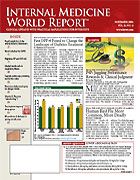Publication
Article
Migraine with Visual Loss May Presage Stroke in Young Patients
Migraine with Visual Loss May Presage Stroke in Young Patients
By Wayne Kuznar
New Orleans—A history of migraine increases the risk of stroke in younger women, and the risk appears strongest for migraine with vision loss, said investigators at the American Stroke Association’s International Stroke Conference 2005.
“Migraine with visual aura, particularly visual loss, was associated with increased stroke risk independent of hypertension, diabetes, smoking, or oral contraceptive use,” said Steven J. Kittner, MD, MPH, of the Baltimore VA Hospital and the University of Maryland, Baltimore, and coinvestigator of a population-based case-control study that involved 59 hospitals in the Baltimore-Washington, DC, area. The study included 386 women (aged 15-49 years) with a clinical diagnosis of first ischemic stroke and 614 age-, race-, and gender-matched controls.
Those with migraine and vision loss had a 65% increased risk of stroke compared with women with no migraine. After controlling for hypertension, diabetes, smoking, and oral contraceptive use, migraine and vision loss was associated with a 70% increased risk of stroke compared with no migraine. Visual aura consisting of spots, lines, or flashing lights was associated with only a 25% increased risk of stroke, which suggests that vision loss is more likely a symptom of transient cerebral ischemia than is seeing spots or lines, said Dr Kittner.
An initial visual loss at least 1 year before stroke was a significant predictor of stroke. Stroke risk increased by 94%, compared with women without migraine, if first aura symptoms occurred >1 year before the stroke but did not increase when first symptoms occurred ≤1 year of stroke.
The prevalence of migraine among young women is about 17%, and about 5% of young women have migraine with aura. Despite the increased stroke risk among young women with migraine with visual loss, the absolute risk of stroke among these women is still low, at 1 per 2500, said Dr Kittner. However, “any person, regardless of age or gender, who has new onset of visual symptoms with or without headache should have the problem investigated,” he advised.
Some studies support that migraine alone is associated with stroke, whereas others show that “migraine with aura convey some of the risk,” he said. A recent study by Italian researchers showed that migraine with or without aura increased ischemic stroke risk in younger men and women. They followed 238 men and women (aged 16-44 years) who had a stroke, and an equal number of age- and sex-matched controls. Among the stroke group, 63 patients reported a history of migraine compared with only 33 in the control group (P = .009).
Regression analysis showed that migraine increased the risk of stroke by 2.7 times, said lead investigator Massimo Camerlingo, MD, head of the neurologic unit at Policlinico San Marco, Osio Sotto (Bergamo), Italy. Migraine with hypertension increased stroke risk by 9-fold. Among the women, “there was no difference between the groups in use of estrogen or progesterone,” said Dr Camerlingo.






